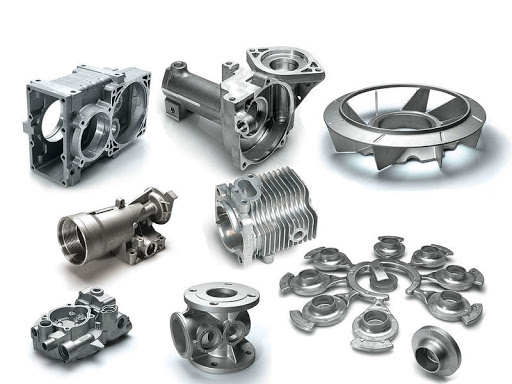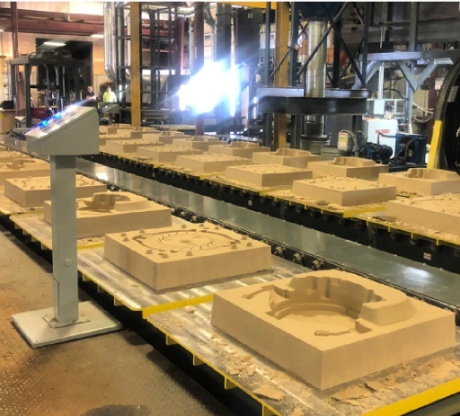Exploring the Diverse Applications and Benefits of Aluminum Foundry in Modern Production
Aluminum factories are essential in today's manufacturing landscape. They generate components that offer numerous markets, including vehicle and aerospace. The light-weight nature of Aluminum incorporated with its longevity makes it a favored choice. Additionally, cutting-edge casting techniques improve manufacturing performance. The ramifications of these improvements on sustainability and future patterns necessitate more expedition. What obstacles and chances exist in advance for Aluminum foundries in this progressing market?
The Duty of Aluminum Foundries in Modern Manufacturing
Aluminum shops play an essential role in modern-day manufacturing, adding significantly to various markets such as auto, aerospace, and building. These centers concentrate on the melting and spreading of light weight aluminum, a lightweight, long lasting material recognized for its excellent corrosion resistance and thermal conductivity. The factories use sophisticated strategies, consisting of sand spreading, pass away spreading, and investment spreading, to produce high-grade parts tailored to certain applications.
Secret Applications of Aluminum Parts Throughout Industries
Across different industries, Aluminum parts are integral to improving performance and efficiency. In the vehicle industry, Aluminum is widely used for engine blocks, transmission situations, and structural components, contributing to lighter vehicles that enhance gas efficiency. The aerospace sector counts on Aluminum for airplane elements, structures, and wings, making the most of its high strength-to-weight proportion to improve flight efficiency.
In electronics, Aluminum is made use of in heat sinks and housings, supplying efficient thermal administration while keeping lightweight qualities (Aluminum Castings). The building market gain from Aluminum in home window frames, roof, and cladding, where durability and looks are important
In addition, product packaging applications use Aluminum for cans and aluminum foils, providing an efficient obstacle against wetness and light. In each of these markets, Aluminum parts not only sustain functional needs yet additionally advertise sustainability with recyclability, making them a favored choice in modern production methods.

Benefits of Aluminum Contrasted to Other Products
The convenience of Aluminum makes it a superior selection over many various other products in producing applications. Among its key advantages is its lightweight nature, which adds to minimized power usage and boosted efficiency in transport and construction markets. Additionally, Aluminum shows superb rust resistance, enhancing the longevity of products without the need for extensive upkeep.
Additionally, light weight aluminum's malleability enables complex designs and forms, satisfying varied market demands, from automobile to aerospace. Its thermal and electric conductivity likewise exceeds that of lots of choices, making it excellent for applications needing warm dissipation or electrical transmission.
Aluminum is highly recyclable, advertising sustainability in making processes. Compared to steel, it provides a positive strength-to-weight proportion, permitting durable yet light-weight structures. Jointly, these features position Aluminum as a favored material, enabling makers to attain both efficiency and sustainability in their products.
Cutting-edge Casting Techniques in Aluminum Foundries
In the domain of Aluminum production, innovative spreading techniques are transforming the manufacturing process and improving the product's applications. Amongst these methods, pass away casting sticks out for its ability to generate intricate shapes with high accuracy and minimal waste. This method enables quick mass manufacturing, making it suitable for markets such as automobile and electronics. Financial investment casting has actually obtained appeal due to its capability to develop detailed layouts with excellent surface area finish, accommodating both huge and small components.
One more noteworthy method is sand spreading, which supplies convenience and cost-effectiveness for producing majorities. Current innovations in 3D printing innovations are likewise being incorporated right into Aluminum spreading, making it possible for quick prototyping and modification. These developments not only improve effectiveness yet likewise increase the possibilities for Aluminum applications across numerous fields, eventually driving the development of modern production techniques.
Sustainability Initiatives in Aluminum Manufacturing
Sustainability efforts in Aluminum manufacturing concentrate on boosting reusing procedures, which greatly lower power consumption and emissions. Executing power effectiveness methods additionally adds to a lowered carbon footprint, making Aluminum an extra eco-friendly product. These efforts mirror the industry's dedication to sustainable manufacturing and source preservation.
Reusing Aluminum Benefits
While Aluminum manufacturing is resource-intensive, recycling Aluminum provides significant benefits that align with sustainability campaigns in manufacturing. Reusing Aluminum needs just 5% of the energy required for primary manufacturing, considerably reducing greenhouse gas emissions. This energy effectiveness not only conserves natural deposits but likewise reduces the environmental impact related to mining and refining raw products. Furthermore, reusing Aluminum sustains a round economic climate by reintroducing products back into the supply chain, therefore decreasing waste and promoting source preservation. The process additionally produces financial advantages through task production in reusing centers and reduces reliance on international Aluminum sources. On the whole, recycling Aluminum is a necessary component of sustainable methods that contribute to a much more environmentally accountable manufacturing landscape.
Power Effectiveness Practices
The Aluminum production field is significantly taking on energy effectiveness methods to enhance sustainability together with reusing initiatives. These efforts concentrate on enhancing power consumption throughout the production procedure. Suppliers are executing innovative modern technologies such as high-efficiency furnaces and clever grid systems, which enable for better energy management and reduced waste. In addition, the integration of sustainable power resources, like solar and wind power, is coming to be more widespread, furthermore decreasing reliance on fossil fuels. Constant tracking and analysis of energy use assist in the identification of inadequacies and opportunities for improvement. Additionally, labor force training on energy-saving strategies assurances that workers actively add to energy conservation efforts, creating a culture of sustainability within the company. These techniques collectively support a more sustainable Aluminum production landscape.
Decreased Carbon Impact
To their website accomplish a decreased carbon footprint, the Aluminum production industry is significantly welcoming ingenious sustainability campaigns. Firms are investing in innovative technologies that minimize energy consumption and discharges throughout the production procedure. The integration of renewable resource resources, such as solar and wind power, plays an important role in decreasing dependence on nonrenewable fuel sources. Furthermore, the recycling of Aluminum scrap substantially decreases the carbon impact, as recycled Aluminum needs just a fraction of the power needed for main manufacturing. Joint efforts amongst producers, federal governments, and ecological organizations additionally drive development in sustainability. By adopting these actions, the Aluminum market not only addresses ecological concerns but additionally improves its one-upmanship in a market progressively focused on environmentally friendly practices.
Future Fads in Aluminum Foundry Technology
Advancement goes to the leading edge of Aluminum Foundry modern technology, driving considerable advancements and improving market practices. Arising trends include the assimilation of synthetic knowledge and artificial intelligence, boosting procedure optimization other and quality assurance. These modern technologies help with anticipating maintenance, lowering downtime and boosting functional efficiency. Additionally, the use of 3D printing and additive manufacturing is getting traction, enabling for complex geometries and decreased material waste.
Sustainability remains a vital focus, with advancements in reusing strategies improving the circular economy of light weight aluminum. Business are increasingly adopting energy-efficient approaches, such as low-pressure die casting, which minimize power usage and emissions. Moreover, electronic twins are becoming commonplace, making it possible for real-time tracking and simulation of Foundry procedures.

Frequently Asked Inquiries
What Security Steps Remain In Location at Aluminum Foundries?
Aluminum shops implement various precaution, including protective equipment, proper ventilation, fire avoidance systems, normal safety training, and emergency procedures to minimize risks connected with high temperature levels, liquified metal handling, and potential exposure to harmful materials.
How Do Aluminum Foundries Guarantee Quality Assurance During Production?
Aluminum foundries implement stringent quality control measures such as regular inspections, material screening, and adherence to sector criteria. These methods ensure consistency in products while minimizing defects, inevitably boosting the dependability and performance of Aluminum find out components.
What Are the Common Obstacles Dealt With by Aluminum Foundries?
Aluminum factories typically face obstacles such as preserving constant quality, taking care of manufacturing costs, guiding governing compliance, addressing tools maintenance issues, and adjusting to changing market demands, all of which can influence operational performance and productivity. - Aluminum Foundry
Exactly how Does the Aluminum Recycling Process Operate In Foundries?
The Aluminum recycling procedure in factories involves accumulating scrap aluminum, thawing it in heating systems, removing pollutants, and casting the molten steel into wanted shapes, therefore reestablishing it into the production cycle successfully and sustainably.
What Are the Job Opportunities Available in Aluminum Foundries?
Task opportunities in Aluminum shops include duties such as Foundry operators, top quality control examiners, upkeep specialists, designers, and manufacturing supervisors. These placements need numerous skill degrees, offering possible for career innovation within the manufacturing field.
Sustainability initiatives in Aluminum manufacturing focus on enhancing recycling processes, which considerably reduce energy usage and exhausts. While Aluminum production is resource-intensive, reusing Aluminum presents significant advantages that straighten with sustainability initiatives in production. Reusing Aluminum requires just 5% of the power required for primary production, significantly minimizing greenhouse gas exhausts. The Aluminum production sector is increasingly adopting energy effectiveness methods to improve sustainability together with reusing efforts. Furthermore, the recycling of Aluminum scrap significantly lowers the carbon footprint, as recycled Aluminum calls for just a fraction of the energy needed for main manufacturing.